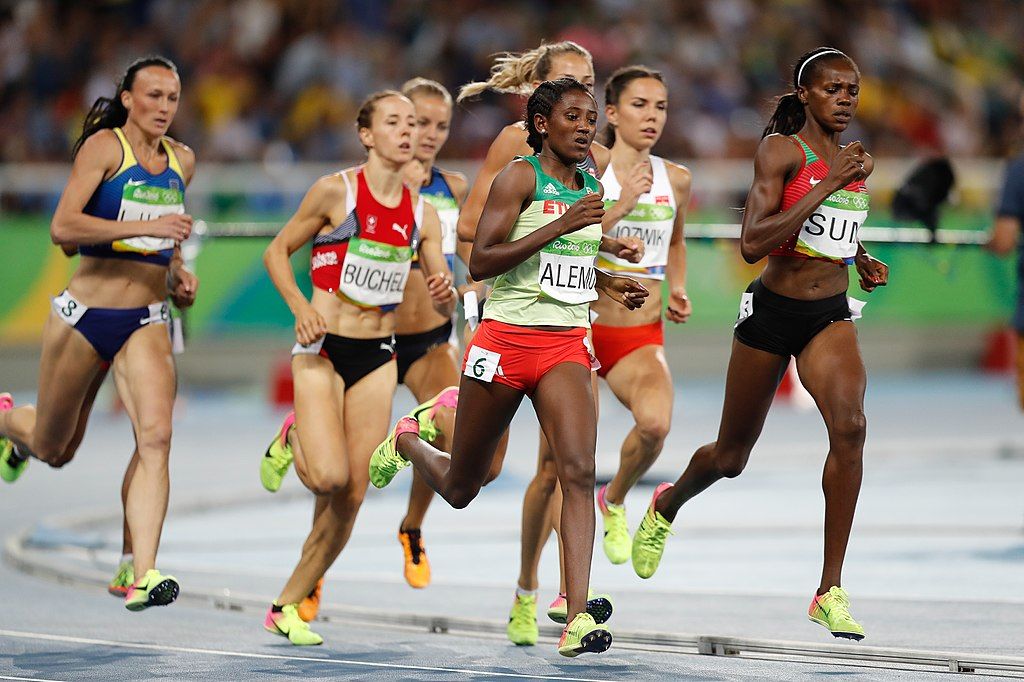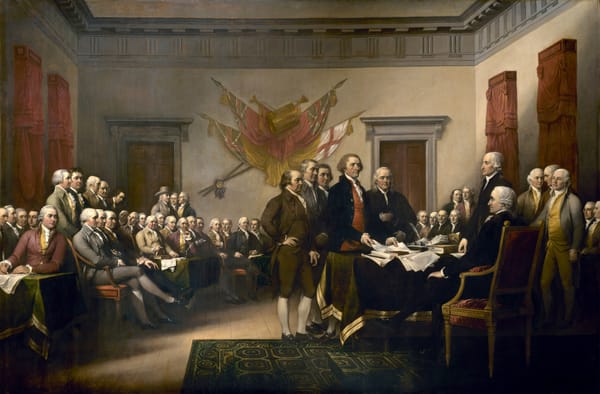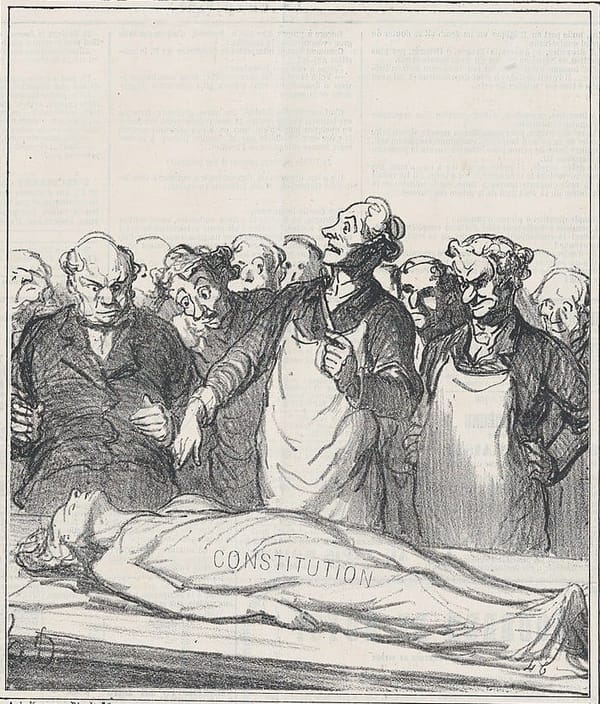Biopolitics and the Illiberal Project

It is very important that I am banned from weightlifting. Very important that I never compete in mixed martial arts, very important that I never win a swimming competition, very important that I never win a footrace. I am a trans woman, you see, and we are too strong, too fast, too tough; [cis] women must be protected from our terrible danger and aggression. Despite the fact that no trans woman has ever “dominated” her sport, despite the fact that we are a tiny minority with marginal power, despite the fact that there is no evidence that we have any “unfair athletic advantage,” preventing us from “conquering” women’s sports is an object of such central political concern that Republicans across the country have no choice but to put it at the top of their agenda.
And not just Republicans and not just today. Across the world, across history, persecution of trans people has been a central priority for illiberal regimes. As we watch the illiberal project pursued to its ultimate ends of violence and lawlessness in Ukraine, I want to try and understand why the persecution of people like me has long been one of that project’s top priorities. It is a puzzle, I suggest, that is best resolved by an understanding of biopolitics.
Biopolitics, biopower, biopessimism
Biopolitics is a fraught term, with a fraught history. The phrase begins its life in 1905, with Rudolf Kjellén’s work Stormakterna (The Great Powers); Kjellén will refine it further in his 1916 Staten som Lifsform—roughly translated, States as Lifeforms. For Kjellén, this is the meaning of biopolitics: to study nation-states as biological superorganisms, competing for the scarce resources of the globe, with individual citizens treated as cells in that great body. In other words, “biopolitics” in its original incarnation was inextricable from emerging eugenics movements and, ultimately, fascism.
In his lecture series “Society Must Be Defended,” delivered in 1975 and 1976, Michel Foucault takes up this same topic from a more critical perspective. He uses the term “biopower” to designate the state’s interest in the biology of its subjects, a new area of discipline and control he took to begin in the 18th century. Rather than uncritically endorsing eugenics on the basis of pseudo-scientific claims that nation-states simply were superorganisms, Foucault was interested in the various ways that these ideas informed state action—for instance, delineate “biologically separate” races, ensure a healthy workforce, promote the birthrate, and so forth.
A different strain in this intellectual lineage predates Foucault—a line of thought given its first thoroughgoing expression in radical feminist Shulamith Firestone’s 1970 The Dialectic of Sex. Rather than focusing on how politics affects biology, Firestone was concerned with how biology affects politics—specifically, reproductive biology. Taking a line from Marx, Firestone argues that there are two sex classes, male and female, and that their different roles in reproductive labor are the base upon which the superstructure of sexism, misogyny, and ultimately patriarchal society are built. Firestone herself took this class distinction to be the target of a revolution in the mode of reproduction, driven by changes in reproductive technology—the condom, hormonal birth control, and mifepristone today; artificial wombs tomorrow.
Later anti-trans feminists such as Mary Daly, in her 1978 Gyn/Ecology, and her student Janice Raymond, in her 1979 The Transsexual Empire, will keep Firestone’s conception of reproductive classes, but instead of taking them as problems to be overcome, treat them as fated and inevitable features of our social world. It is from these later developments that this line of thought will eventually take its name: “biopessimism,” the view that deep-seated features of human biology will inevitably structure our politics in patriarchal ways.
Personally, I find these all to be deeply limited conceptions of the topic of biopolitics. Contra Foucault, politics does not merely concern the application of state power, but the total interplay of humans-living-among-humans. Contra Kjellén, treating humans from a biological perspective does not entail spurious and pseudoscientific conceptions of nation-states or “races” acting as superorganisms. Contra Daly, biology is not some structuring force that stands outside of history.
By “politics” I mean the total interplay of humans-living-among-humans. By “biology” I mean humans considered not as mind or soul but as flesh. Thus biopolitics refers to the interaction between humans as political creatures and humans as biological creatures, with neither one determining the other, but rather interacting in a dynamic and historical fashion. To understand what I mean, let us turn to a case study: gender and sports.
Athletic achievement and gender anxiety
Sport—that is to say, the whole array of athletic endeavor, competitive and recreational, team and individual—is a fruitful example of biopolitics in operation. On the one hand, sport is clearly connected in some way to the powers and potentialities of the human body. On the other, it is a social construction, whose rules, regulations, and context are all, in that respect, political. The history of tennis provides an instructive example of this two-aspectedness. Watch a game of professional tennis, and you’ll see two human bodies in motion, trained to their peak, probing the limits of the human capacity to hit a ball moving at a hundred and fifty miles per hour. This reveals something deep and true about humans as biological creatures, or at least it feels like it does. But the game you’re watching, and its particular contours, have been continuously shaped by social construction. The shape of the court, the dimensions of the court, the composition of the court, the composition of the ball, the height of the net, the size of the racket, the materials of the racket, the rules for serving—all of these have been changed and adapted over the years in order to produce the particular kind of (serve-centric) game you just watched.
This two-aspectedness makes sport a central concern for politics. As the Olympics once again grind to a close, and the great powers of our age once again compare their medal counts to see who has produced the most exquisite human specimens, we see one obvious interest politics takes in humans as biological organisms. But politics goes beyond the national interest, and I focus on a different political interest’s interventions in the world of sports: patriarchy.
Patriarchy has no offices, controls no territory, holds no elections. But we can analyze it as a social structure and arrive at an idea of its interests. Following Kate Manne and the ideas adumbrated in her book Down Girl, we can distinguish between patriarchy, a material structure of power, sexism, the ideology that underpins that material structure, and misogyny, the “enforcement arm” of the above, deployed against the nonconforming. Following Julia Serano and the ideas developed in her book Whipping Girl, we can distinguish between different strains in that ideology: what she calls oppositional sexism and traditional sexism. Roughly speaking: “men and women are distinct, immutable categories” and “women are worse.” Following the ideas developed by the Combahee River Collective in their “The Combahee River Collective Statement,” we can recognize the white supremacist inflection of the foregoing: “the ideal man is white, the ideal woman is white.”
Let’s put these ideas together. The total package of Modern Sexism looks something like this: men and women are fundamentally biologically distinct kinds of human beings, designed (by God or evolution or both) for different purposes. Men are designed for hunting, for warfare, for domination; women are designed for birthing, for nurturing, for submission. There are insurmountable physical differences: in reproductive capacity, in strength, in skill. And there are insurmountable mental differences: in rationality, in courage, in kindness. The ideal man is strong, commanding, fertile, and white; the ideal woman is gentle, accepting, fertile, and white. And patriarchy is the structure of power that elevates men who fit that ideal over men who don’t, women who fit that ideal over people who don’t, and men over other people. Misogyny is the enforcement of this power and these ideas by both men and women against those who do not conform.
What does this have to do with sports? Far too much, it turns out. We can see the operation of misogyny in an immense array of interventions in the world of sports, structuring the rules to ensure the sexist image of the world is the one sport reflects. Here is an non-exhaustive list of some of these methods of gender reinscription.
- Differential event formats. For instance, gymnastics scoring rules effectively require women to dance and men to flair.
- Differential training regimens. For instance, for the 2021 March Madness, the NCAA provided radically different qualities of training equipment for male and female athletes.
- Direct exclusion of athletes. Pseudoscientific requirements have been used to directly exclude athletes such as Caster Semenya and Lia Thomas; Zhang Shan was excluded based on nothing at all.
- Direct discrimination and discouragement. Elite female athletes from Serena Williams to Lindsey Horan are harassed and discriminated against for being “too muscular.”
- Differential pay. Famously, the US Women’s National Soccer Team is paid far less than their underachieving male counterparts.
- Differential event promotion and attention. Across the board, women’s sports are less promoted, less advertised, and less watched than men’s sports.
This looks like an endless list of inscrutable “anti-woman sentiment,” but the conception of misogyny having the goal of upholding patriarchal power and sexist ideology—in this case via biopolitics—clarifies the singular intention of all of these interventions. Over and over again, misogyny intervenes in the social construction of sports to maintain a singular goal: “the woman with the gold medal should be white, should be femme, should be slower than the men.” The enforcement arm of patriarchy is especially directed at us when we don’t fit the model of the ideal woman—white, graceful, inferior—and most especially directed at us when we win. Simone Biles, Caster Semenya, Lia Thomas—all of them faced pushback precisely because they excelled while not fitting the preferred model. Too fast, too strong, too black, too trans, and they’ll find a way to make sure you’re out. Contrast those cases with that of Michael Phelps: not a single rule was changed to discourage him, despite his long list of genetic advantages, because men like him are supposed to win.
Notably, this is not a one-way movement, but a dynamic interplay between patriarchy as a political interest and sports as a physical display. Misogyny structures the performances seen on the field—and those performances are in turn taken to justify sexism. Female gymnasts are graded on their dance moves, so they dance; male gymnasts are graded on strength-intensive flairs, so they flair—and this distinctly gendered performance, “strength” vs. “grace,” is then taken to justify the very structures that create it in the first place.
The current push for anti-trans sports policies must be seen as the tip of this iceberg—or, the canary in the coal mine, if you think that a Republican commission to set acceptable hip-to-knee ratios for women’s sports is going to stop with excluding trans women. Trans people and trans women especially press on the raw wounds of patriarchy’s illusions—our existence proving both that the boundaries between the male and female form are far more permeable than patriarchy would like to admit, and more strongly that being a woman can be something worth choosing. It’s no wonder patriarchy would prefer us out of sight and out of mind.
The illiberal project
The above conception of the biopolitics of sport has more general implications. In particular, it can help illuminate the structure of the illiberal project. That phrase—”the illiberal project”—is perhaps a bit tendentious. I mean it to encompass a world-wide resurgence of strongmen leaders, including Trump in America, Orbán in Hungary, Duterte in the Philippines, Bolsonaro in Brazil, Johnson in Britain, Putin in Russia, and too many others to name. The details of their political programs vary in the details, but shared structural features include support for patriarchy, support for racial hierarchy, and opposition to liberal democracy. These political movements are animated by common purpose, or at least common cause, as we can see from their very own interconnections—the Heritage Foundation importing ideology from British anti-trans activists, American evangelicals donating to the Canadian convoys, Russian intelligence services working for Trump’s election, Rod Dreher making a pilgrimage to Hungary to learn from Orbán’s ways. I consider all these movements to be part of the same illiberal project: overturning the liberal order and restructuring society based on “the natural order.”
“The natural order.” This idea is at the deep, deep heart of illiberal politics, and they aren’t at all subtle about it: the obsession with nature permeates the writings of illiberal intellectuals such as Rod Dreher, Sohrab Amari, and Adrian Vermeule. This is a conception infinitely older than Aristotle, but he is the one who gives our name to it in his Physics: telos, the natural purpose of a thing. For Aristotle, telos was both explanation and evaluation: the telos of a chick was to grow up to be a healthy chicken, for example, which both explained why that chick grew in the way it did, and provided a standard by which to assess defect, deformity, and deviance. In his Politics, Aristotle based the structure of the family on these sames telos-derived lines. Men know the truth, and therefore rule over the family; women exist to bear children and obey their husbands; children exist to grow into men and women; and “natural slaves” exist to serve the foregoing. It’s no accident that this picture of the natural order so closely mirrors the illiberal project’s ideal picture—and that of patriarchal ideology. “Men ARE superior to women,” understood as simultaneously a normative and a descriptive claim—not a statement of universal generalization, not a statement of universal prescription, but a statement of The Truth Of The World, from which it Occasionally Deviates. That’s telos.
The trouble with telos is that it’s an illusion. There is no such thing as a natural purpose; there is no such thing that is both cause and standard. The illiberal project faces a fundamental cognitive dissonance when it turns out that we “deviants” can also apprehend the truth—witness, for instance, Rod Dreher’s frothing meltdown over an openly gay and kinky nuclear engineer. Here is my contention: the illiberal project turns to biopolitics in order to reconcile this fundamental problem. The double movement described above is the structural support of the illusion of telos, in cases far beyond gender and sport. “They’re dirty, so why would we let them clean themselves.” “They’re ignorant, why would they need education.” “They’re poor, why would they need opportunities.” This double movement represents the elision of fact and value that is fundamental to the illiberal project.
A liberal biopolitics
I have argued that biopolitics is at the heart of the illiberal project. Illiberal societies work to create the conditions that justify them: to artificially impose hierarchy and give it the appearance of naturalness. Anti-trans sport policies are merely one aspect of this larger program. Biopolitics is an essential lens for any liberal analysis of the illiberal project: for understanding why they pursue the ends they do and the larger political project their interventions serve.
But biopolitics is not—should not be—solely the domain of illiberal regimes. Too often, liberal theorists approach political questions in which the “mere materiality” of bodies and interests is taken as given, or worse simply not examined at all. But we are biological beings, and our biologies must necessarily impact politics. A liberal biopolitics begins from the recognition that a liberal society must aim to create liberal citizens—must aim, in other words, to liberate humanity from the tyranny of biology. In other words, to bring biology and its inbuilt hierarchies under the rule of liberal politics. This means reproductive autonomy—access to birth control and abortion its familiar aspects—but more deeply, it means biological autonomy: the capacity to become who we are. Instead of taking “natural classes” of human beings as given—instead of taking men and women as given—we must work towards material conditions in which biological embodiment is as much a matter of choice as religion, speech, and association.
Featured Image is Athletics Night at Engenhão, by Fernando Frazão





